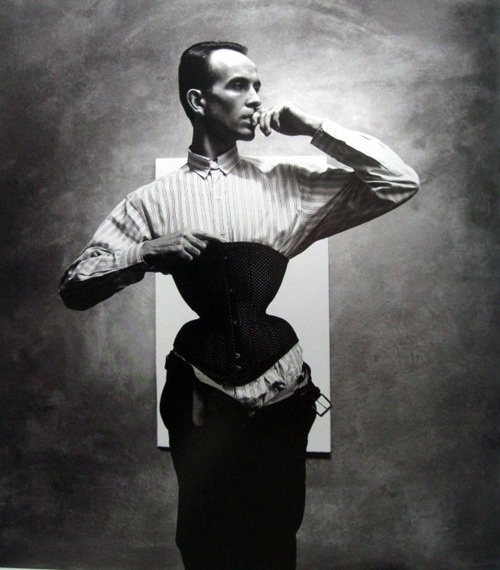Tight lacing can be risky for some individuals with medical conditions. Please consult your doctor before following any of the suggestions in this section!
What is Waist Training?
Waist training uses a corset to reduce your waist circumference without reducing your weight. You can combine waist training with weight loss, but they are separate processes. Waist training is controversial, and there's a lot of nonsense on both sides. Here's a quick summary of the main inaccuracies:
- Waist training is dangerous. When done correctly, waist training is perfectly safe. Many healthy people have made remarkable waist reductions with no ill effects. Like any activity, there are medical conditions that will prevent you from waist training safely. Most people will have no trouble. If you are uncertain, please consult a doctor.
- Waist training is permanent. Waist training using only a corset is not permanent. To get a permanent waist reduction, you need to lose weight. Wearing a corset can help reduce your appetite, which will help weight loss. Many long-term waist trainers have noticed that their waist remains smaller for a few hours after they remove their corset. You can exploit this fact when you want to wear clothes (such as bikinis) where a corset would not be appropriate, but a small waist would be great. But this is not a permanent reduction.
Who are some famous waist-trainers?
Undoubtedly, the most famous waist-trainers in the world are Cathie Jung and Mr. Pearl.
 Cathie holds the Guinness Book of World Record's 2011 record for the world's smallest waist. Her waist is about the size of the lid on a jar of mayonnaise! To achieve this, she has worn her corset 24 hours a day for most of her life. Cathie's waist is so small that people suspected she had some of her ribs removed (oh yes, that old thing again). She has posted a photo of her X-rays showing that all her ribs are still intact. Cathy is healthy and happy at 82 years old as of this writing!
Cathie holds the Guinness Book of World Record's 2011 record for the world's smallest waist. Her waist is about the size of the lid on a jar of mayonnaise! To achieve this, she has worn her corset 24 hours a day for most of her life. Cathie's waist is so small that people suspected she had some of her ribs removed (oh yes, that old thing again). She has posted a photo of her X-rays showing that all her ribs are still intact. Cathy is healthy and happy at 82 years old as of this writing!
Mr. Pearl is a famous corset maker who has collaborated with some of the leading fashion designers of the day, such as Thierry Mugler. But he is also a corset wearer. Like Cathie Jung, he wears his corset 24 hours a day and has achieved an 18-inch waist!

From these examples, it should be clear that, given the proper dedication, you can get significant waist reductions without risk.
Is there an Ideal Waist Size?
This is a fascinating question, and science has an answer to it. If you are interested in being attractive, it turns out that there is an ideal waist-hip ratio, and it is surprisingly similar across very different cultures. There's some evidence that the cause of this could be our evolutionary history. While the preferred bust size and weight preferences differ when you move from one culture to another, all cultures prefer a waist/hip ratio of 0.7. In other words, the waist size should be 70% of the hip size. Poor peasants from India, young Indonesians, Hispanics, African-American men, and women all find women with this waist/hip ratio the most attractive.
Researchers found that even a small increase in waist size significantly decreased attractiveness and made the study subjects appear overweight. And the impact of being overweight on judgments of attractiveness was strongly negative. The waist/hip ratio holds even for groups who prefer heavier women, such as uneducated landless laborers from India. And this can't be the influence of western culture: traditional Indian mythology describe a beautiful woman's body with phrases like "her hips and breasts were full, her waist slender."
Moving from the third world to the U.S., we find Marilyn Monroe's measures of 36-24-34 (waist/hip = 71%) while the controversial Twiggy was 31-24-33 (73%). The beautiful Ellie MacPherson, one of the most popular models of all time, is 36-24-35 (68%). Kate Moss, Sophie Lauren, and Venus de Milo all have waist/hip ratios of around 70%.
What fascinates me about this is that there's substantial evidence that women with a 70% waist/hip ratio also have peak fertility and health. Humans like to think they are free from evolutionary forces, but that's not the case. Evolution bred us to reproduce, and the process of natural selection favors those who can successfully do it over those who can't. In modern terms, you come pre-programmed to love a woman with a waist-to-hip ratio of 70%, and there's nothing you can do about it.
Too much science? Try this: SheDaddy wants to bimbofy us, which comes down to turning us into as sexual and attractive beings as possible. Evolution has determined that the waist/hip ratio required to do this is 70%. Since we lack those naturally spectacularly sexual dimorphic curves, the corset is her artificial sexualizing device. I admit it's more fun to think about this way.
Enough Theory. Let's Get an Example
My hips are about 40 inches (101.5 cm). Multiply this by 0.7, and you get your target waist size: 28 inches (71 cm). If you lose significant weight, your target waist size may change as your hips reduce.
Choosing a Corset.
Not every corset is suitable for waist training. Make sure yours is strong enough and that the measurements are correct. Tell your vendor that you intend to use the corset for waist training. You will wear this for long hours, and it will be tight. That is going to be uncomfortable. A well-fitting corset will ease your path.
Corsets sizes are specified by the target waist size. If you get a 30-inch corset and lace it until it is closed, your waist will be 30 inches. But that won't be the external measurement of your waist. Corsets have thickness and typically add at least 2 inches, sometimes more, to your external waist measurement. So if you want a 30-inch waist measurement with your corset on, you need to purchase a 28-inch or, possibly, smaller corset. Your vendor should be able to advise you. Check the size when you first receive your corset and if it's not correct, exchange it for a smaller size.
How is Waist Training Done?
As usual with corsetry, there are different approaches, each of which has passionate advocates. I've decided to use what is widely known as the "Roller Coaster Method." With this method, you baby-step your way towards your goal. Here's an outline:
- Choose an initial amount to reduce your waist. If you are a new corset wearer and have just finished seasoning your corset, 2 inches is a good amount.
- Choose a step value. A typical value is 1/2 inch. Metric types can use 1 cm.
- If your waist is 40 inches without the corset, you will wear your corset at 37.5 inches. (40 inches - the initial amount of 2 inches - 0.5 inches). Do this for two hours a day for three days.
- Now wear the corset at 37.5 inches for 4 hours for three more days.
- Finally, wear the corset for 6 hours a day, for three more days, at the same size.
- Reduce the corset by another 1/2 inch (or 1 cm) and begin again at 2 hours.
Keep this up until you reach your desired waist size. Giving yourself a day off from the corset once a week is a good idea. Even with that, if you follow this program, you will soon find yourself at your goal.
My Training Regimen
Using the Roller Coaster Method (or any method) should not be applied rigidly. Listen to your body and use good judgment and sense. It's not uncommon to hit a "wall" where you don't seem able to reduce anymore. If that happens to you, stick with your current waist reduction for another few days, then try again. Keep at it until you can move down that next 1/2-inch. And, of course, the real world can intrude, making it difficult to maintain your corset training schedule. Try to handle these intrusions with a smile, and you will return to your training schedule soon!
Measuring with your Corset On
Keep the tape around the waist of the corset and keep it level. Don't pull it too tight.
Initial Starting Amount
After seasoning my corset at a 2-inch reduction for a couple of weeks, I discovered that I could bring my corset down to 3-inches without any problem. I am, regrettably, squishier than I would like. I suggest you do what I did and choose a challenging but comfortable amount to start. If you are in great shape with little "squish," you probably won't be able to start with a three inch reduction. That's the price you pay for being amazing. I've finished my first 1/2 week at this amount and will be moving it down another 1/2 inch today. Here's how my Schedule looks:
- First week:
- Mon. Tues. Wed: 3-inches for two hours
- Thurs. Fri. Sat: 3-inches for four hours
- Sunday: No Corset
- Second Week:
- Mon. Tues. Wed: 3-inches for six hours
- Thurs. Fri. Sat: 3.5-inches for 2 hours
- Sunday: No Corset
- Third Week:
- Mon. Tues. Wed. 3.5-inches for four hours
- Wed. Thurs. Fri. 3-5-inches for 6 hours
- Sunday: No Corset
And so on, until I reach my target goal.
Medical Considerations
The main consideration with waist training is your core muscle strength. Over time, your body can start to rely on the corset for support, and this can cause your muscles to atrophy, making you dependent on the corset. I don't want this to happen, so I exercise my abdominal muscles daily (without wearing the corset, of course!) I focus on the transverse and oblique abdominal muscles. I try not to over-strengthen the rectus abdominis since that can interfere with waist reduction.
Lacing for Waist Training
I use a special method for lacing my corset for waist training that works quite well, in fact, much better than the usual lacing method. I noticed this on Cathie Jung's corset photographs and tried it for myself. To learn more, please see my article on Corset Lacing Tips
Practical Considerations
It is not always easy to find a block of time where you can wear your corset for four or six hours. One simple way to deal with this is to wear your corset while you sleep. I have done this and don't find it a problem, at least so far, but many people cannot sleep while corsetted. In such cases, you must resort to stealth corsetting when you wear your corset hidden under your everyday clothing. If you know in advance that you will do this, you can select a corset that would be compatible with stealth corsetting. There aren't many options, but at the least, you can use a pale or neutral color rather than black or bright red. There's almost no way to hide a corset under tight clothes, but I've found I can successfully do it under a business suit as long as I wear my jacket. You can also wear loose T-Shirts or sweatshirts if the circumstances allow that.
That's it for today. Thanks for reading, and if you have something nice to say or a good idea or suggestion, you can always send me a note!